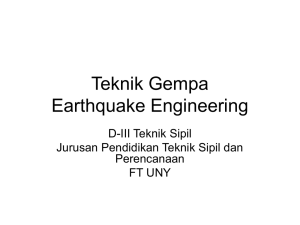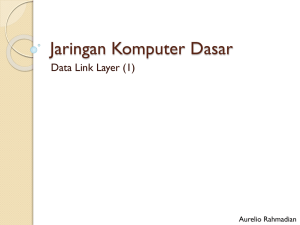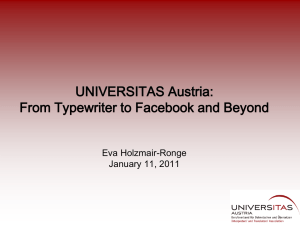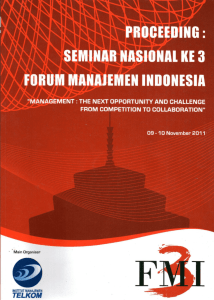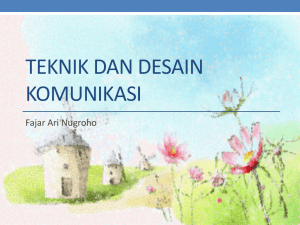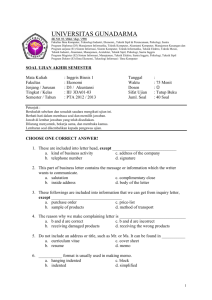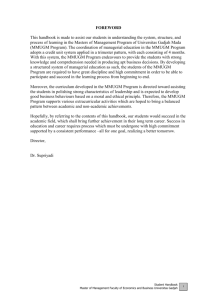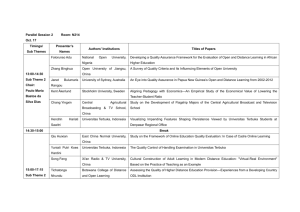Definisi Teknik Industri - Trisakti Blogger Community
advertisement
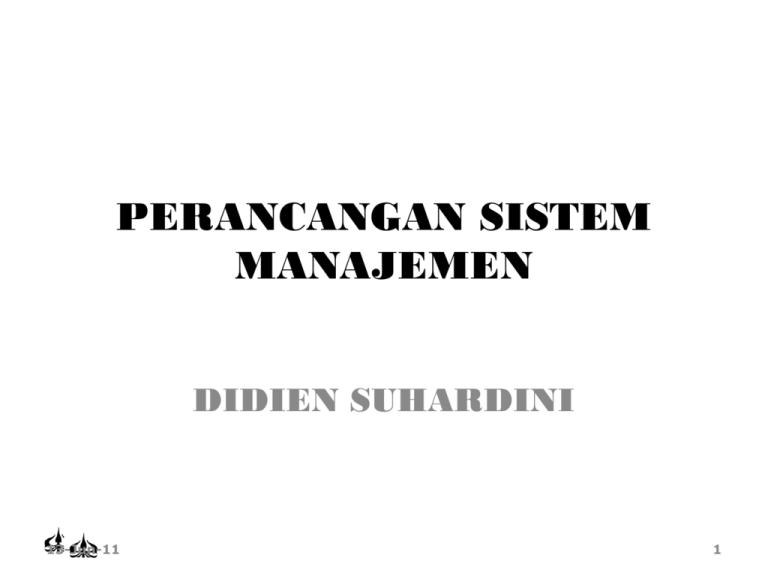
PERANCANGAN SISTEM MANAJEMEN DIDIEN SUHARDINI 13-Jun-11 1 Perancangan apa yang dilakukan TI? Sistem Terintegrasi Sistem Industrial (Sistem Manufaktur) Sistem Aktivitas Insani Jurusan Teknik Industri Universitas Trisakti Sistem Pengendalian Manajemen Didien Suhardini PTI-Management System Design 2 Sistem Aktivitas Insani Berkaitan dengan berbagai aspek fisik tempat kerja dimana aktivitas insani terjadi: • • • • • • • • • • Proses Manufaktur Material dan semua sumber daya lainnya Mesin dan peralatan Metode yang dilakukan pekerja dalam melaksanakan tugas Tata letak fasilitas dan spesifikasi aliran material Peralatan dan prosedur Material Handling Perancangan Tempat kerja Ruang Penyimpanan, perancangan dan lokasi. Prosedur untuk pemeliharaan dan rumah tangga Prosedur keamanan Jurusan Teknik Industri Universitas Trisakti Didien Suhardini PTI-Management System Design 3 Sistem Pengendalian Manajemen Berkaitan dengan proses dan prosedur yang berhubungan dengan perencanaan, pengukuran dan pengendalaian semua aktivitas di dalam organisasi: • • • • • • • • • Sistem Perencanaan Manajemen (PMB, BBT) Prosedur Peramalan Penganggaran dan analisis Ekonomi (Anbi) Sistem penggajian dan pengupahan (HRM) Rencana Insentif dan sistem hubungan pekerja lainnya (HRM) Rekrutmen, pelatihan dan penempatan karyawan (HRM) Perencanaan Kebutuhan Material Pengendalian Persediaan Penjadwalan produksi Jurusan Teknik Industri Universitas Trisakti Didien Suhardini PTI-Management System Design 4 Sistem Pengendalian Manajemen(2) • • • • • • • • • • Pengeluaran barang Pelaporan kemajuan dan status Prosedur tindakan perbaikan Sistem Informasi Sistem Pengendalian Kualitas Pengurangan dan pengendalian Biaya (Anbi) Alokasi Sumber daya Perancangan Organisasi (PO) Sistem Pendukung Keputusan (Ankep) Manajemen Kinerja (pengukuran, perbaikan dan pengendalian) Jurusan Teknik Industri Universitas Trisakti Didien Suhardini PTI-Management System Design 5 Manajemen: Proses membuat sesuatu terjadi secara efektif dan efisien melalui dan dengan orang lain (the process of getting things done, effectively and efficiently, through and with other people). Efisiensi: berarti mengerjakan tugas dengan benar, mengacu pada hubungan antara masukan dan luaran, berusaha meminimasi biaya sumber daya (means doing the task correctly; refers to the relationship between inputs and outputs; seek to minimize resource cost). Efektifitas: berarti mengerjakan tugas yang benar, pencapaian tujuan (means doing the right task; goal attainment). Jurusan Teknik Industri Universitas Trisakti Didien Suhardini PTI-Management System Design 6 Apa yang dilakukan TI? Produksi/ Operasi . Produk & jasa . Proses Manufaktur Fasilitas . Metode Kerja Standar . PPC . Kualitas . Pemeliharaan Jurusan Teknik Industri Universitas Trisakti Sistem Manajemen . Sistem Informasi . Finansial & sistem biaya . Personalia (HR) - Organisasi & manajemen . Analisis Keputusan Didien Suhardini PTI-Management System Design Penunjang Korporat . Perencanaan komprehensif. (Stratagei) Kebijakan & . Prosedur - Pengukuran Kinerja 7 Management Processes Planning Organizing Actuating/Leading Controlling Jurusan Teknik Industri Universitas Trisakti Didien Suhardini PTI-Management System Design 8 Definitions Planning: includes defining goals, establishing strategy, and developing plans to coordinate activities. Organizing: includes determining what tasks are to be done, who is to do them, how the tasks are to be grouped, who reports to whom, and where decisions are to be made. Leading: includes motivating employees, directing the activities of others, selecting the most effective communication channel, and resolving conflict. Controlling: the process of monitoring performance, comparing it with goals, and correcting any significant deviations. Jurusan Teknik Industri Universitas Trisakti Didien Suhardini PTI-Management System Design 9 Perencanaan Tujuan Strategi Aktivitas A Aktivitas B Aktivitas N - Sumber daya/biaya - waktu - kualitas Jurusan Teknik Industri Universitas Trisakti Didien Suhardini PTI-Management System Design 10 Tipe Rencana Breadth of use Strategic Tactical kerangka waktu Long term Short term Jurusan Teknik Industri Universitas Trisakti Kekhususan Frekuensi Directional Single use Specific Standing Didien Suhardini PTI-Management System Design 11 Kualitas sebagai senjata rahasia • Benchmarking: Mencari praktek terbaik diantara kompetitor maupun non kompetitor yang mendorong kinerja terbaik. • ISO 9000 series: standar yang menggambarkan proses dimana auditor independen memeriksa apakah pabrik, laboratorium, dan kantor sudah memenuhi standar manajemen kualitas. • Six Sigma: a philosophy and measurement process that attempts to design in quality as a product is being made. Jurusan Teknik Industri Universitas Trisakti Didien Suhardini PTI-Management System Design 12 Organization Design is concerned with constructing and changing an organization’s structure to achieve the organization’s goal. involves difficult choices about how to control-that is, coordinate and motivate-the task in an organization’s ability to create value. Organization Development is a system-wide application of behavioral science knowledge to the planned development, improvement, and reinforcement of the strategies, structures, and processes that lead to organization effectiveness (Cumming & Worley, 2001) Jurusan Teknik Industri Universitas Trisakti Didien Suhardini PTI-Management System Design 13 Approach Theory Application Macro Organizational Theory (OT) Organizational Design (OD) Micro Organizational Behavior (OB) Jurusan Teknik Industri Universitas Trisakti Human Resources Management (HRM) Didien Suhardini PTI-Management System Design Organizational Development (ODv) 14 Differentiation • The process by which an organization allocates people and resources to organizational task and authority relationships that allow the organization to achieve its goals. • Vertical differentiation: the way an organization designs its • • • • hierarchy of authority and creates reporting relationships to link organizational roles and subunits Horizontal differentiation: the way an organization groups organizational tasks into roles and roles into subunits (functions and divisions) Hierarchy: a classification of people according to authority and rank. Tall organization: an organization in which the hierarchy has many levels relative to the size of the organization. Flat organization: an organization that has few levels in its hierarchy relative to its size. Jurusan Teknik Industri Universitas Trisakti Didien Suhardini PTI-Management System Design 15 Integration • The process of coordinating various tasks, functions, and divisions so that they work together and not at cross-purposes. Jurusan Teknik Industri Universitas Trisakti Didien Suhardini PTI-Management System Design 16 Dimensions of Organization structure • Complexity : number of different components or subsystems in an organization • Formalization: the use of written rules and procedures to • • • standardize operation or explicitness of expectation regarding work means and procedures Centralization: an organizational setup whereby the authority to make important decisions is retained by managers at the top of the hierarchy or the locus of decision making authority along the vertical dimension Decentralization: an organizational setup whereby the authority to make important decisions about organizational resources and to initiate new projects is delegated to managers at all levels in the hierarchy. Configuration: the shape of organization: number of level and span of control Jurusan Teknik Industri Universitas Trisakti Didien Suhardini PTI-Management System Design 17 Jurusan Teknik Industri Universitas Trisakti Didien Suhardini PTI-Management System Design 18 Alternative ‘Model’ Structures • The simple or entrepreneurial structure • The functional structure • The divisional (product, geographic, market) structure • The conglomerate/multidivisional structure • The hybrid structure • The matrix structure (Adhocracy) • The professional and machine bureaucracy structure • The mechanistic structure and organic structure • The network structure - outsourcing • The boundary-less organization Jurusan Teknik Industri Universitas Trisakti Didien Suhardini PTI-Management System Design 19 Common elements in organizations (Mintzberg) • The strategy apex: top-level managers, who are charged with the overall responsibility for the organization • The middle line: managers, who connect the operating core to the strategy apex • The operating core: employees who perform the basic work related to the production of products and services • The support Staff: people who fill the staff units, who provide indirect support services for the organization • The techno-structure: analysts, who have the responsibility for effecting certain forms of standardization in the organization. Jurusan Teknik Industri Universitas Trisakti Didien Suhardini PTI-Management System Design 20 Controlling Yes Planning Actuating Evaluation No Feedback Jurusan Teknik Industri Universitas Trisakti Didien Suhardini PTI-Management System Design 21 Linking Planning To Action • Mission • Key Result Area Where? • Goals • Objectives • Action Program How? • Resources How much? • Execution Do it! • Tracking How • Corrective Action Expedite? • Appraisal RewardReinforcement Jurusan Teknik Industri Universitas Trisakti Why? What? Who? Where? Well? Didien Suhardini PTI-Management System Design 22 Vertical Linkages Corporate Strategy Business Strategy Functional Strategy Operation/Production Management Jurusan Teknik Industri Universitas Trisakti Didien Suhardini PTI-Management System Design 23 Management level Corporate/Business Business/Functional Operational Jurusan Teknik Industri Universitas Trisakti Didien Suhardini PTI-Management System Design 24 Time Frame Operational Jurusan Teknik Industri Universitas Trisakti Functional Business Didien Suhardini PTI-Management System Design Corporate 25 Corporate Strategy Scope : Corporate/Enterprise Objectives : Growth Performance: ROI/ROE Formulation : Market Penetration Market Development Product Development Diversification Jurusan Teknik Industri Universitas Trisakti Didien Suhardini PTI-Management System Design 26 Ansoff Strategy m a r k e t n e w Market Development e x i s t i n g Market Penetration existing Jurusan Teknik Industri Universitas Trisakti Diversification Product Development Product Didien Suhardini PTI-Management System Design new 27 Business Strategy Scope : SBU Objectives : Competitiveness Performance: Market Share Formulation : Cost Leadership Differentiation Focus Jurusan Teknik Industri Universitas Trisakti Didien Suhardini PTI-Management System Design 28 Scope : Business Function (Marketing, Production/Operation, HR, Finance, R&D, Procurement) Objectives : Competitive Priority Performance: Target Quality Cost Delivery Flexibility Safety Jurusan Teknik Industri Universitas Trisakti Didien Suhardini PTI-Management System Design 29 Implementing Strategy Employee survey Customer survey Culture Change Vision/strategy Competitive benchmarking Business Process Re-engineering Total Quality Just-in-time Time-based strategy Empowerment Jurusan Teknik Industri Universitas Trisakti Didien Suhardini PTI-Management System Design 30 Generalized Structured of Management Control system Objectives Performance Criteria Modified Performance Criteria System Operation Yes Performance Evaluation Corrective Action No No Performance Criteria met Jurusan Teknik Industri Universitas Trisakti Yes Non per formance Justified? Didien Suhardini PTI-Management System Design Performa n ce crite ria need 31 Balanced Scorecard (BSC) Is a strategy management and implementation system that comprises a Strategy Map and a accompanying Balanced Scorecard (BSC) of strategic measures, targets, and initiatives. Jurusan Teknik Industri Universitas Trisakti Didien Suhardini PTI-Management System Design 32 Strategy Map • Serves as a strategy implementation roadmap in that it describes the high-level strategic objectives that the organization must deliver if it is to successfully execute its strategy. Jurusan Teknik Industri Universitas Trisakti Didien Suhardini PTI-Management System Design 33 BSC philosophy the successful strategy implementation is the result of causal relationships within and between typically three non-financial perspectives (learning and growth, internal, customer) and one financial perspective. 3-6 perspective depending on their own cultural or performance requirements: + safety (Hongkong railway network operator). Subordinate Courts, Singapore has three perspectives : community, organization, employee. Jurusan Teknik Industri Universitas Trisakti Didien Suhardini PTI-Management System Design 34 What Is the Balanced Scorecard? • Measurement System? • Strategic Management System? • Communication tool? Jurusan Teknik Industri Universitas Trisakti Didien Suhardini PTI-Management System Design 35 Five Principles of The Strategy-Focused Organization 1. Translate the strategy to operational terms. Sub components: Strategy maps and BSC 2. Align the organization to the strategy Sub components: Corporate roles, Business Units synergies, and Shared service synergies. 3. Make strategy everyone’s everyday job. Sub components: Strategic awareness, Personal scorecards, and Balanced pay checks. 4.Make strategy a Continual Process Sub components: Link budgets and strategies, analytics and information systems and strategic learning. 5. Mobilized change through executive leadership. Sub components: Mobilization, governance process, and strategic management systems. Jurusan Teknik Industri Universitas Trisakti Didien Suhardini PTI-Management System Design 36 Benefits of BSC Usage • Creates a more team based, performance oriented culture, people across the business are getting better and better at thinking strategically, and are sharing a common strategic language. • People have a far better understanding of how their everyday work links to the vision and mission statement and can take a more balanced, as opposed to largely internal view of their work. • Better able to identify problems, rectify them and then communicate action and progress to all of our stakeholder groups in a simple format. Jurusan Teknik Industri Universitas Trisakti Didien Suhardini PTI-Management System Design 37 Activity-Based Management (ABM) • Encompasses actions that increase efficiency, lower costs, and enhance asset utilization. • ABM strives to either increase capacity or lower spending, so that fewer physical, human and working capital resources are required to generate the firm’s product and services. • The financial benefits from ABM can be measured by reduced costs, higher revenues (through better resources utilization), and cost avoidance (because the expanded capacity of existing resources obviates the need for additional investments in capital and people) Jurusan Teknik Industri Universitas Trisakti Didien Suhardini PTI-Management System Design 38 Activity-Based Costing • Provides an analytic model that represents how individual product and customer use different quantities of the services supplied by indirect and support resources. • In the first stage resource drivers link to the expenses of resources supplied to the activities and processes performed (link between ABC and the BSC) • Can accurately trace organizational expenses to a procurement, manufacturing, distribution or delivery process (BSC’s internal perspective) Jurusan Teknik Industri Universitas Trisakti Didien Suhardini PTI-Management System Design 39 Learning Organization • “organizations where people continually expand their capacity to create the results they truly desire, where new and expansive patterns of thinking are nurtured, where collective aspiration is set free, and where people are continually learning how to learn together (Senge, 1994 p3). • is one that proactively creates, acquires, and transfers knowledge and that changes its behaviour on the basis of new knowledge and insights (Kreitner and Kinicki, 1998). • is an organization skilled at creating, acquiring, and transferring knowledge, and at modifying its behaviour to reflect new knowledge and insight (Garvin 1993 p 80). • is one which employees share knowledge, allowing deeper understanding and more through approach to problem solving as a result, the organization is able to grow and change in keeping with its environment. (Garvin, 2000). Jurusan Teknik Industri Universitas Trisakti Didien Suhardini PTI-Management System Design 40 Organizational Learning • is a process of detecting and correcting error (Argyris, 1977, p 116). • the process of improving action through better knowledge and understanding (Fiol and Lyles, 1985, p 803). • prioritises the creation and acquisition of new knowledge, and emphasizes the role of people in the creation and utilization of that knowledge. In these sense, Organizational Learning represents an important route to competitive advantage (Denton, 1998 p 206). Jurusan Teknik Industri Universitas Trisakti Didien Suhardini PTI-Management System Design 41 The Five Disciplines/skills/characteristics • System thinking –is the process of seeing the causal relationship between independent actions of an organization. Systems thinking views an organization in holistic manner where actions of one part of an organization have causes and effects in other parts of an organization. • Personal mastery – the discipline of continually developing individual self fulfilment and commitment to one’s aspirations. • Mental models - are the “deeply ingrained assumptions, generalizations, or even picture or images that influence how we understand the world and how we take action.” • Building shared vision – the discipline that develops shared • “pictures of the future”. • Team learning – is the practice of a team gaining new insights and knowledge through dialogue between individuals of teams. Those five disciplines are interrelated to each other Jurusan Teknik Industri Universitas Trisakti Didien Suhardini PTI-Management System Design 42 Organizational Learning Capability Yeung, Ulrich, Nason, Von Glinow (1999) • • • • • is based on an organization’s ability to (1) generate ideas, (2) generalize those ideas, and (3) identify Learning Disabilities. Generation refers to acquiring, discovering, inventing, and sourcing ideas. Examples: Centres of excellence, management innovation, new products/service creation, and starting up of new program. Generation comes through the four Learning Styles: experimentation, competency acquisition, benchmarking, and continuous improvement. Generalization involves sharing ideas across boundaries within an organization. Learning cannot occur unless ideas are transferred over time, physical space, and/or the organizational hierarchy. (1) Four Learning Disabilities that affect generation, such as: – Blindness: inability to asses environmental opportunities and threat accurately – Simpleminded-ness: deficiencies in analysis and solution generation – Homogeneity: lack of variety in skills, information, ideas, and values – Tight coupling: excessive coordination among different organizational unit (2) Three Learning Disabilities that affect generalization: – Paralysis: inability to implement new actions or procedures – Superstitious learning: inability to interpret accurately that meanings of experience – Diffusion deficiency: inability to share ideas with all relevant parts of the organization. Jurusan Teknik Industri Universitas Trisakti Didien Suhardini PTI-Management System Design 43 Learning Capabilities • are conceptualised as “complex bundles of skills and collective learning exercised through organizational processes that ensure superior coordination of functional activities.” (Day, 1994). • is the potential capabilities that might be gained by a firm from engaging in mechanisms and processes for planned learning (Gerbing et al, 1994; Slater and Narver, 1994). . • is a consequence of sophisticated assimilation of knowledge, where productive activity is a function of the firm’s capacity to harness and integrate knowledge attributed to multi individuals and groups. (Grant,1996) • represent the set of core competencies, which are defined as the special knowledge, skills and technological know-how that differentiate an organization from its competitors and processes that enable an organization to adapt to its environment. (Kreitner and Kinicki, 1998, 2002) Jurusan Teknik Industri Universitas Trisakti Didien Suhardini PTI-Management System Design 44 Intellectual/Knowledge Capital Is the possession of the knowledge, applied experienced, organizational technology, customer relationships and professional skill that provide the organization with a competitive edge in the market. Market Value = Financial Capital + Intellectual Capital Intellectual Capital = Human Capital + Structural Capital. Human Capital: competence, attitude, intellectual agility (innovation, imitation, adaptation and packaging), employee skill, talent and knowledge. Jurusan Teknik Industri Universitas Trisakti Didien Suhardini PTI-Management System Design 45 Structural capital 1. Organizational Capital - Process Capital: structure, culture, leadership, employee alignment, teamwork work processes, techniques, practical knowledge and knowledge management. - Innovation capital: intellectual property and intangible assets (renewal capability, protected commercial right, talents used to create and rapidly bring to market new products and services). - Information capital: databases, information systems, networks and technology infrastructure 2. Relationship Capital: customer (brand images, good will, loyalty, satisfaction, price sensitivity, longevity), suppliers, shareholders, alliance partners and other stakeholders, 3. Renewal and development capital Jurusan Teknik Industri Universitas Trisakti Didien Suhardini PTI-Management System Design 46
